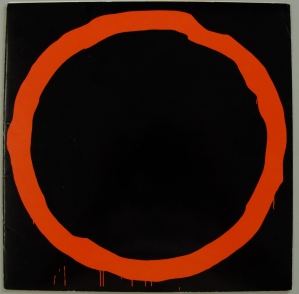The soil in process
January 17, 2010
Kazuo Shiraga (1924-2008)







Kazuo Shiraga working with his wife Fujiko. Work II, 1958; Tenkasei Nyuunryo, 1962; Tenkaisei Kohoji, 1964; Kosha, 1992. Challenging Mud, 1955.
Hanging on ropes to slide over the canvas at quickly changing paces, Kazuo Shiraga resolutely spreads the coloured oil paste, guiding it through the surface and allowing it to guide him. Each painting is a short vibrant event, each canvas a different new dance, in which the material is in continuity with both the matter and the energy of the body.
Challenging the Mud allows for a better understanding of this bond of solidarity between the body and the material of the world, since the mud can be regarded as Earth itself, and the power of the body as Earth’s creative principle, shown as the force of life, of a living being.
According to Mircea Eliade, Earth is a primary intuition of the foundation of every expression of existence. It is a cosmic hierophany, or revelation, not only because of its permanence, size and solidity, and the variety of things it bears, but also because “all that is on earth is united with everything else” in “existences that reveal themselves directly to man”.
The “cosmological solidarity” is an organic solidarity, “a magic, sympathetic bond between the earth and the forms it has engendered”. It is a biological unity “due to the life which is the same” in all those forms of existence, and it stands for earth’s fertility as much as for earth’s regenerative attribute: “Everything that comes from the earth is endowed with life, and everything that goes back into the earth is given new life”.
The accomplishment of a work of art is, thus, equated to the natural creative workings of the Earth itself.
[1] ELIADE, 1971: 254: “Every expression of life is the result of the fertility of the earth”.
… all I’m painting is circles. Because they’re easy.
January 15, 2010


Jiro Yoshihara at his atelier in 1970; cover of the catalogue of Yoshihara’s 40 years retrospective exhibition of 1967.
In Gutai, the scarcity and the playfulness of the theoretical discourse allows for an understanding of their pursuit of ‘concreteness’ as an erasure of language. Under Jiro Yoshihara’s determination, the works of the members of the group did not bear titles, since the question of meaning was irrelevant for the Gutai artistic enterprise and, thus, any discursive translation of content within the verbal realm.
This figures directly relevant for the presupposition that the experimental procedures adopted by Gutai aimed at accessing a creative ‘embodied core’, a pre-verbal consciousness, as well as at the suspension of discursive processes or automatisms that might translate into language, verbal or otherwise.
The dismissive attitude towards content in works of art and, thus, over theoretical pondering (Yoshihara would evaluate the artists’ works as ‘good’ or ‘not good’) and, conversely, the intuitive assessment of concrete statements in art that were candid and bore the energy of uniqueness and universality (a numinous resonance, possibly), were personal factors in Jiro Yoshihara that enabled the development of the pressing drives in each of the Gutai artists, especially during the first experimental years of the group.

